

Measure distances from machines for safety equipment (fire extinguishers, fire blankets, etc.).Determine accurate room dimensions to ensure correct chemical concentration for Clean Agent Fire Suppression system.
#Power point measure distance install#

Determine footprint of equipment or office cubicles to be installed, to aid in layout.Verify that new construction satisfies usage requirements.Determine how square a room or object really is, or whether the sides are completely parallel.

Verify CAD drawings for as-built and design drawings.Measure height or width of buildings¹ and other objects, by triangulation if needed.Provide accurate estimates for bidding out work (HVAC, electrical, cable, maintenance).
#Power point measure distance how to#
Accuracy is up to ± 2 mm (5/64 in).įluke asked users for ideas on how to use a laser distance meter and got back quite a few. The Fluke 417D laser distance meters measure distance to a target up to 40 m (131 ft) away using the unit's laser spot and can do a quick calculation of area (square feet/meters) and volume. Your original formula - if you could supply a source for that I can check it against data I have.What would you do, if you had a laser distance meter to measure distance, instead of a regular measuring tape or wheel? 2.7 to 4.3 (Free space has n =2 for reference). Because you are calibrating at a known distance you don't need to take into account the frequency of your transmission and this simplifies the equation.ĭ is distance in metres and n is the propagation constant or path-loss exponent as you mentioned in your question i.e. Where A is the received signal strength in dBm at 1 metre - you need to calibrate this on your system. The formula is #19 on page 3 and basically it is this:. I've been having a little look on this and there is a simpler formula you can use based on this document. There is a standard formula for calculating minimum theoretical signal level needed by a receiver for a given data rate. It gives an indication of likely bit error rates for instance. Fade Margin level is 14dB or lowerįade margin is the difference in power levels between the actual signal hitting the receiver and the bottom-line minimum signal needed by the receiver to work. Normal: Link would not be stable all the time, but should work properly. Good: Link should give you a good surfing experience. Notes from: suggest that fade margin varies from 14dB to 22dB Excellent: Link should work with high reliability, ideal for applications demanding high link quality. I have an Ralink RT5370 chipset wifi dongle with this specification: Ralink 5370 spec Pr = Signal power (dBm) at distance - Get this value by testingį = signal frequency in MHz - 2412~2483.5 MHz for Ralink 5370īut I am not able to figure out how to calculate the fade margin.īased on some findings, fade margin = sensitivity of receiver - received signalīut then again, how do I get sensitivity of the receiver? Po = Signal power (dBm) at zero distance - Get this value by testing N = Path-Loss Exponent, ranges from 2.7 to 4.3 The relationship b/w RSSI and Distance is ( source PPT):

This part might be solved via this solution: Trilateration using 3 latitude and longitude points, and 3 distances


 0 kommentar(er)
0 kommentar(er)
